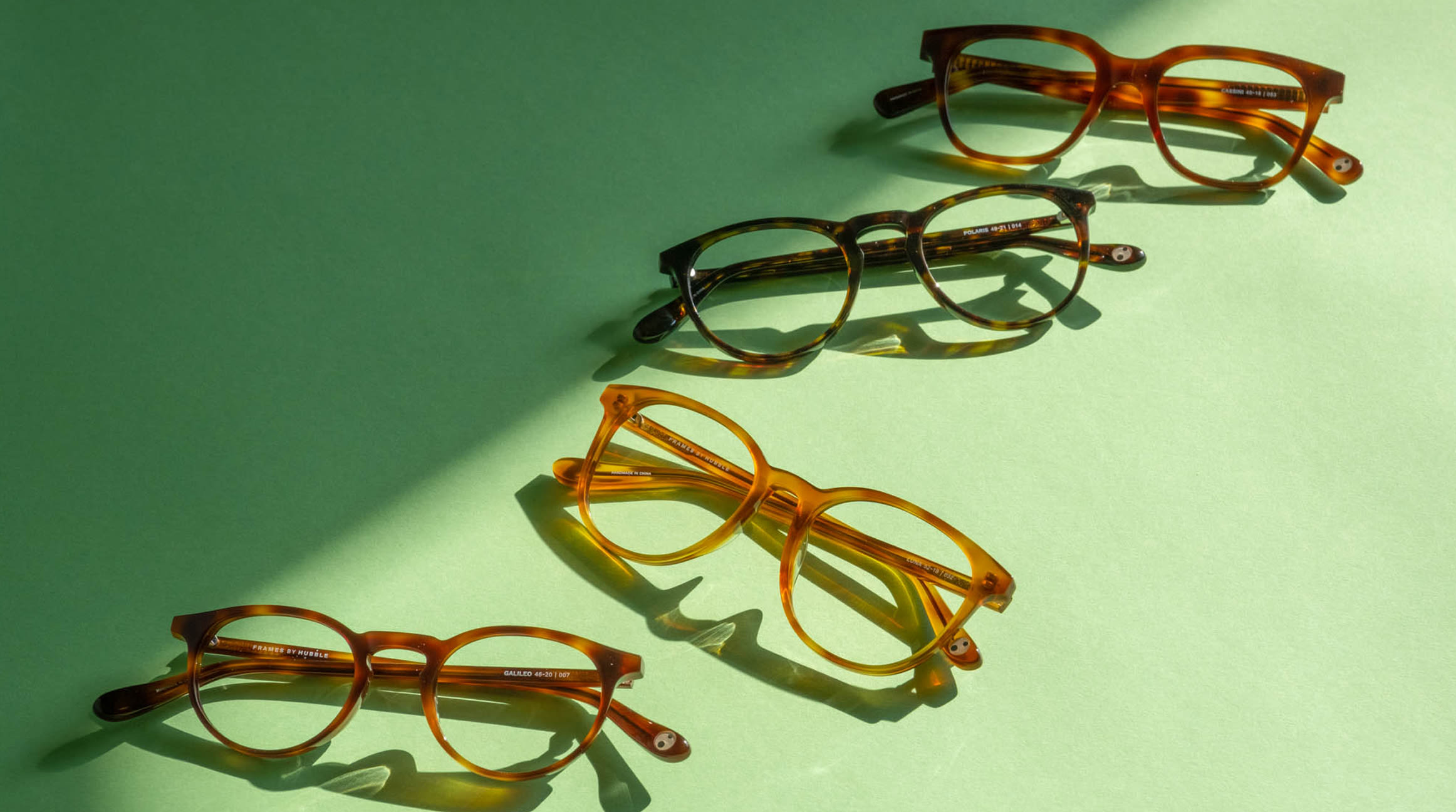Types of Glasses: A Guide to Choosing the Right Pair

Choosing a new pair of glasses should be a fun experience. Unlike choosing the best contact lenses, finding the right pair of glasses comes with the bonus of showing off your new frames. And while glasses trends may change from year to year, finding the right type of glasses ultimately comes down to what suits your personal style and needs.
That being said, with so many different types of glasses out there, choosing your next pair can be a daunting task. To help you make the best decision, let’s take a look at a few areas to consider when it comes time to get new glasses.
Lens Type
The most important factor when it comes to choosing the right type of glasses isn’t the frames—it’s the lenses. Finding the best eyeglass lenses for your individual needs will ensure you get the best performance out of your glasses. Let’s start by taking a look at some of the most common lens types.
Single-VisionSingle-vision lenses correct vision in only one way. For example, if you only struggle to see objects far away, your lenses only need to correct this part of your vision. This is the most common type of lens.
BifocalsBifocal lenses correct vision in two ways. The lenses are divided into two areas that allow the wearer to use each as needed. Typically, bifocals are split so that the top half of the lens corrects nearsightedness and the bottom half corrects farsightedness.
TrifocalsSimilar to bifocals, trifocals correct vision in three different ways. Trifocal lenses add an intermediate range alongside the far and near ranges featured in bifocals.
ProgressivesBifocals and trifocals are collectively known as multifocal lenses. Progressives, on the other hand, are another type of multifocal lens that aims to improve the experience for wearers by removing the visible borders between different areas on the lens.
Bifocal and trifocal lenses feature distinct lines on the lenses. For most people, this can take some time to get used to. Progressive lenses remove these lines and instead blend these areas together as a gradient. This makes for a less disruptive experience—however, this comes with a higher price tag, as progressive lenses also typically cost more than their bifocal or trifocal counterparts.
Lens Material
Like contact lenses, eyeglass lenses are available in several types of materials that can influence performance. While eyeglass lenses used to often be made of glass—hence their name—most lenses today are made of plastic.
High-index PlasticHigh-index plastic lenses are an upgrade over traditional plastic lenses. Ideal for those with higher prescriptions, high-index plastic lenses allow for lenses to be lighter and thinner while still providing the necessary level of correction.
PolycarbonatePolycarbonate lenses are a great option for children or for those who may need additional protection for their glasses. That’s because polycarbonate lenses are highly impact-resistant. This additional durability, however, doesn’t come with additional weight—polycarbonate lenses are thinner and lighter than traditional plastic lenses.
That being said, polycarbonate lenses aren’t ideal for those with higher prescriptions or astigmatism, as they may lead to lower quality of vision in these cases.
TrivexTrivex lenses are a fairly new type of lens material that is similar to polycarbonate. Trivex lenses are also lightweight and impact-resistant, but they may provide better vision correction than polycarbonate for some wearers.
Frame Material
Once you’ve decided on the type of lenses to go with, now comes the fun part: frames. The first consideration with frames is what type of material to go with.
PlasticPlastic frames are a popular choice for their versatility and affordability. In fact, plastic is the most common material for glasses.
Plastic frames come in a wide variety of shapes, finishes, and designs, making it easy to find the style you’re looking for—and typically at a lower price than other materials. That being said, plastic frames are less durable than some other options.
AcetateAcetate frames are very similar to traditional plastic frames—in fact, you may not even notice a difference. However, there are a few key differences that may make acetate the right choice for you.
Traditional plastic frames are petroleum-based, whereas acetate frames are plant-based. The frames are made from natural fibers that, in addition to being more eco-friendly, also make the frames more durable than traditional plastic.
Acetate frames are also available in numerous styles and designs, and they can even hold complex textures better than plastic, which provides additional options such as wood-grain.
MetalEyeglass frames also come in a variety of different metals including stainless steel, aluminum, and titanium. While frames may differ depending on the specific metal used, metal frames are generally more durable—and more costly—than plastic frames.
Due to their enhanced durability, metal frames are ideal for thinner frame styles. This also keeps the glasses lighter and adds a touch of sophistication to any outfit. However, while metal glasses are a durable and stylish option, they often cost more than plastic, especially premium metals like titanium or magnesium.
Frame Type
Once you’ve identified which material is best for you, it’s time to decide on which type of frames to go with. There are three main frame types to choose from, each with their own pros and cons.
Full-RimmedFull-rimmed frames wrap completely around the lenses. This makes them an ideal fit if you have a higher prescription, as the thicker lens is enclosed within the frame. Full-rimmed frames also tend to be more durable as there is more material to cushion the lenses.
Full-rimmed frames come in a wide range of colors, sizes, and designs, making them an attractive option if you want to make a statement with your glasses.
Semi-RimlessSemi-rimless frames remove the bottom portion of the frames and only cover the top portion of the lens. This combines the full-rimmed and rimless looks, making for an attractive hybrid option that offers both stylistic freedom and sleek design.
Semi-rimless frames sacrifice a bit of durability compared to full-rimmed frames as the bottom half of the lens is exposed. However, this makes them a bit lighter and ultimately more comfortable for some wearers.
RimlessRimless frames feature—you guessed it—no rims around the lenses. This makes them a great choice if you’re looking for a modern, minimalist look or if you want to keep your frames low-profile.
Rimless frames also offer a wider field of view and are the most lightweight option. However, being that the lenses are completely exposed, they require more care than other frame types in order to avoid lens damage.
Frame Shape
You’ve decided on a frame type—now, you’re on to finding the perfect shape. Frame shape is often the first thing people consider when looking for a new type of glasses; however, all the factors outlined above will ultimately play into which frame shape is best for you. And with the number of frame shapes available, this can make your decision a bit easier.
SquareSquare frames are a classic design that is still very popular today. Square frames provide an angular look that is often accented with full-rimmed frames.
RectangularSimilar to their square cousins, rectangular frames also provide an angular look, but one that isn’t quite as stark as square. This makes them a highly versatile choice—one that suits nearly anyone. For this reason, rectangular frames are one of the most common frame shapes.
RoundLike square frames, round frames offer a vintage aesthetic that have made them a popular choice in recent years. That being said, round glasses can be notoriously tough to pull off—the style lends to a sense of confidence for those bold enough to try.
BrowlineBrowline frames are the classic semi-rimless style—thick, often plastic rim on top and no rim on the bottom. Browline glasses are another vintage style that has made a comeback in recent years and may be more forgiving than traditional round frames.
Cat EyeCat eye frames feature a long, slightly curved upper trim that lead into thick areas in each of the upper corners. This iconic, curvy design makes cat eye glasses an excellent choice if you’re seeking a confident, glamorous look.
AviatorWhile traditionally thought of as sunglasses, aviator frames have recently made a splash in the prescription glasses scene as well. Originally worn by pilots, aviators feature broad lenses that make them a bold choice brimming with vintage appeal.
Face Shape
One of the best ways to decide which frame shape to go with is to go by your face shape. Certain frame shapes pair better with certain face shapes, allowing you to get a major style boost along with your new glasses.
In general, you want to balance your facial features with your frame shape. For example, if you have a round face, you want frames that feature an angular design, such as rectangular frames. Conversely, if you have an angular face, round frames can help soften the edges.
To learn more, check out our guide to choosing glasses by face shape.
Choosing the Right Type of Glasses
As you can see, there’s a lot to consider when choosing a new type of glasses—from the type of lenses to the shape of your face. However, by considering each category and choosing the option that best suits your needs and style, you can walk away with an amazing new pair of glasses that you’ll be itching to show off.
No matter what type of glasses you choose, Hubble has you covered. Our glasses lineup features iconic styles and trendy designs, ensuring that you can find the right pair for your needs. Our glasses are hand-assembled and made with high caliber lenses, ensuring that your pair will perform as great as they look.
Getting new glasses is fun—so getting started today by checking out Hubble’s men’s and women’s glasses.




